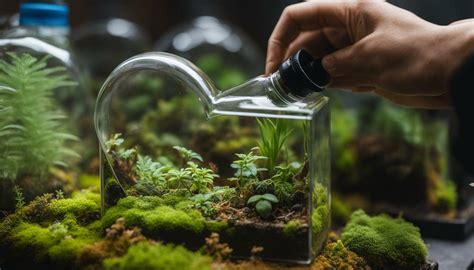Introduction
Terrariums, enclosed ecosystems that house plants and other organisms, offer a unique and captivating glimpse into the wonders of nature. While they require meticulous care and attention, terrarium maintenance can be an incredibly rewarding hobby for those seeking to delve deeper into the art of nurturing miniature worlds. For experts, mastering the nuances of terrarium maintenance opens up a world of possibilities, from creating thriving microclimates to experimenting with exotic species.

Fundamental Principles of Terrarium Maintenance
- Light: Light is essential for plant growth, and the amount and type of light required will vary depending on the species. Most plants prefer bright, indirect light, while some may tolerate low light conditions.
- Water: Water is crucial for plant hydration, but overwatering can lead to root rot. Use a well-draining substrate and water only when the soil is slightly dry to the touch.
- Temperature: Terrariums can be kept at room temperature, but some species may require warmer or cooler environments. Monitor the temperature carefully and adjust accordingly.
- Humidity: Humidity is essential for many terrarium plants. Mist the terrarium regularly or use a humidifier to maintain the desired humidity level.
- Ventilation: Ventilation is necessary to prevent stagnant air and promote airflow. Ensure that the terrarium has proper airflow holes or vents.
Advanced Terrarium Maintenance Techniques
1. Managing Microclimates
– Different plants require specific microclimates. By creating zones within the terrarium, you can accommodate the needs of multiple species.
– Use dividers or barriers to separate microclimates with different light intensities, temperature gradients, or humidity levels.
2. Plant Selection and Compatibility
– Choose plants that are compatible with each other and the terrarium’s environment.
– Consider the size, growth rate, and light requirements of each species.
– Avoid overcrowding the terrarium to prevent competition and disease.
3. Substrate Management
– The substrate is the foundation of the terrarium ecosystem. Use a well-draining substrate that is appropriate for the plant species.
– Monitor the substrate for compaction or deterioration and replace it as needed.
4. Pest and Disease Control
– Terrariums can be susceptible to pests and diseases.
– Regularly inspect plants for signs of infestation or disease.
– Treat pests with appropriate insecticides and isolate diseased plants.
Future Trends in Terrarium Maintenance
1. Automation and Technology
– Terrarium maintenance can be simplified through the use of automated watering systems, LED lighting, and temperature controllers.
– These technologies enable remote monitoring and adjustment of terrarium conditions.
2. Exotic Plant Exploration
– As terrarium knowledge expands, hobbyists are venturing into rare and exotic plant species.
– Specialized techniques are required to cultivate these species successfully in terrarium environments.
3. Biome Recreation
– Terrariums are evolving into miniature recreations of specific biomes.
– Experts are creating complex ecosystems that mimic the environmental conditions found in rainforests, deserts, and other natural habitats.
Comprehensive Guide to Terrarium Maintenance
The following tables provide a comprehensive overview of terrarium maintenance for experts:
| Parameter | Ideal Range | Monitoring |
|---|---|---|
| Temperature | Species-specific (generally 65-85°F) | Thermometer |
| Humidity | Species-specific (generally 60-80%) | Hygrometer |
| Light | 8-12 hours per day | Light meter |
| Water | Soil slightly dry to the touch | Moisture meter |
| Substrate | Well-draining, species-appropriate | Inspection |
| Pest control | Regular inspections | Insecticide |
| Disease control | Isolation, treatment | Visual examination |
Effective Strategies for Terrarium Maintenance
- Regular Monitoring: Monitor terrarium conditions daily and adjust as necessary.
- Precise Environmental Control: Use calibrated equipment to maintain specific temperature, humidity, and light levels.
- Water with Precision: Water sparingly and only when the soil is dry to the touch.
- Fertilize Appropriately: Use diluted fertilizer sparingly to avoid nutrient burn.
- Avoid Overcrowding: Limit the number of plants in the terrarium to prevent competition and disease.
Common Questions and Answers
1. How often should I water my terrarium?
– Water only when the soil is slightly dry to the touch.
2. What type of light is best for a terrarium?
– Most plants prefer bright, indirect light.
3. How can I control humidity in a terrarium?
– Mist the terrarium regularly or use a humidifier.
4. What are the signs of overwatering in a terrarium?
– Yellowing or wilting leaves, root rot.
5. How can I prevent pests in my terrarium?
– Regularly inspect plants for signs of infestation and treat promptly.
6. What is the best way to fertilize plants in a terrarium?
– Use a diluted fertilizer sparingly to avoid nutrient burn.
7. How often should I repot plants in my terrarium?
– Repot plants as needed when they become overcrowded or rootbound.
8. What are the best species of plants for a terrarium?
– Choose plants that are compatible with each other and the terrarium’s environment.
Testimonials
“Terrarium maintenance for experts has become my passion. The intricate balance of nature within these miniature worlds fascinates me.” – Sarah Jones, Master Terrarium Enthusiast
“Mastering the art of terrarium maintenance has enabled me to cultivate rare and exotic species that thrive in these controlled environments.” – David Smith, Expert Terrariologist
“The comprehensive guide to terrarium maintenance for experts is an invaluable resource. It has helped me elevate my terrarium maintenance skills to a whole new level.” – Emily Carter, Terrarium Enthusiast
“The terrarium maintenance techniques I’ve learned have transformed my miniature ecosystems into thriving biomes.” – Michael Johnson, Terrarium Curator





















